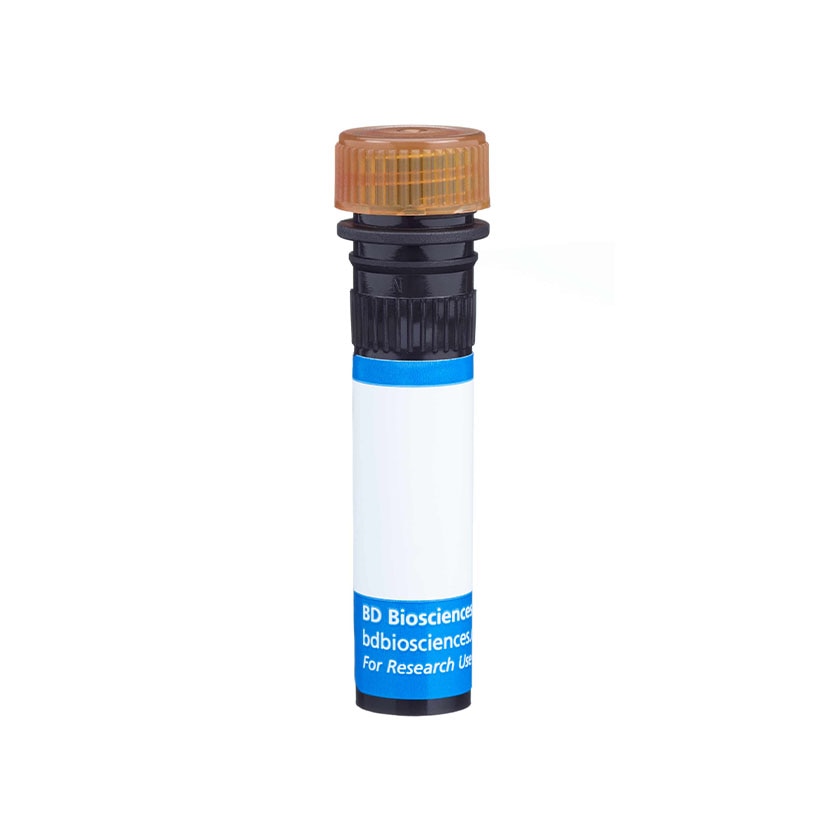Old Browser
Looks like you're visiting us from {countryName}.
Would you like to stay on the current country site or be switched to your country?




Flow cytometric analysis of DNA synthesis by TK-1 cells using PerCP anti-BrdU antibody. TK-1 cells were either pulsed with 50 µM BrdU for 1 hour (left panel) or were not pulsed (right panel). Staining was performed using the procedure from the BD Pharmingen™ FITC BrdU Flow Kit (Cat. No. 559619). The permeabilized cells were stained with the PerCP anti-BrdU antibody (Cat. No. 560808) followed by the DNA-specific dye, DAPI dihydrochloride, at 1 µg/ml (SIGMA, Cat. No.D9542). Two-color flow cytometric dot plots showing the correlated expression patterns of Dapi vs BrdU were derived from gated events with the forward and side light-scatter characteristics of viable lymphocytes. Flow cytometry was performed with doublet discrimination using a BD™ LSRII System.


BD Pharmingen™ PerCP Mouse anti-BrdU

Regulatory Status Legend
Any use of products other than the permitted use without the express written authorization of Becton, Dickinson and Company is strictly prohibited.
Preparation And Storage
Recommended Assay Procedures
Please see the detailed protocol under "Cell Cycle/DNA Analysis" at our website: www.bdbiosciences.com/resources/index.jsp
Product Notices
- This reagent has been pre-diluted for use at the recommended Volume per Test. We typically use 1 × 10^6 cells in a 100-µl experimental sample (a test).
- Caution: Sodium azide yields highly toxic hydrazoic acid under acidic conditions. Dilute azide compounds in running water before discarding to avoid accumulation of potentially explosive deposits in plumbing.
- Source of all serum proteins is from USDA inspected abattoirs located in the United States.
- PerCP is a photosynthetic accessory pigment from Glenodinium species of dinoflagellates, which is excited by the 488-nm light of an Argon ion laser and fluoresces at 675 nm. Therefore, PerCP-labelled antibodies can be used with FITC- and R-PE–labelled reagents in most single-laser flow cytometers with no significant spectral overlap of PerCP fluorescence with that of FITC or R-PE. PerCP has been reported to undergo significant photobleaching, the magnitude of which increases as laser power is increased or beam focus is narrowed. For third-color flow¬cytometric analysis using ≥25-mW laser power, we recommend PE-Cy5-, PE-Cy7–, or PerCP-Cy5.5-conjugated reagents.
- For fluorochrome spectra and suitable instrument settings, please refer to our Multicolor Flow Cytometry web page at www.bdbiosciences.com/colors.
- Species cross-reactivity detected in product development may not have been confirmed on every format and/or application.
- Cy is a trademark of GE Healthcare.
- Please refer to www.bdbiosciences.com/us/s/resources for technical protocols.
Bromodeoxyuridine (BrdU) is an analog of thymidine that can be incorporated into newly synthesized DNA by cells entering and progressing through the DNA synthesis (S) phase of the cell cycle. The amount of incorporated BrdU depends on the amount of time that the cells are exposed to BrdU (pulse time), the rate of cell division, and whether the cells are in early, mid, or late S phase. Investigators can identify cycling cells in an asynchronous cell population and determine cell cycle kinetics by detecting incorporated BrdU.
The 3D4 monoclonal antibody reacts with BrdU, but not other nucleotides, in single-stranded DNA. Random cleavage (nicking) of cellular DNA with DNase I permits the binding of the antibody to incorporated BrdU.

Development References (3)
-
Dolbeare F, Gratzner H, Pallavicini MG, Gray JW. Flow cytometric measurement of total DNA content and incorporated bromodeoxyuridine. Proc Natl Acad Sci U S A. 1983; 80(18):5573-5577. (Methodology: Flow cytometry). View Reference
-
Keren DF, Hanson CA, Hurtubise PE. David F. Keren, Curtis A. Hanson, Paul E. Hurtubise., ed. Flow cytometry and clinical diagnosis. Chicago: ASCP Press; 1994:1-676.
-
Miltenburger HG, Sachse G, Schliermann M. S-phase cell detection with a monoclonal antibody. Dev Biol Stand. 1987; 66:91-99. (Clone-specific: Immunofluorescence).
Please refer to Support Documents for Quality Certificates
Global - Refer to manufacturer's instructions for use and related User Manuals and Technical data sheets before using this products as described
Comparisons, where applicable, are made against older BD Technology, manual methods or are general performance claims. Comparisons are not made against non-BD technologies, unless otherwise noted.
For Research Use Only. Not for use in diagnostic or therapeutic procedures.
Report a Site Issue
This form is intended to help us improve our website experience. For other support, please visit our Contact Us page.
